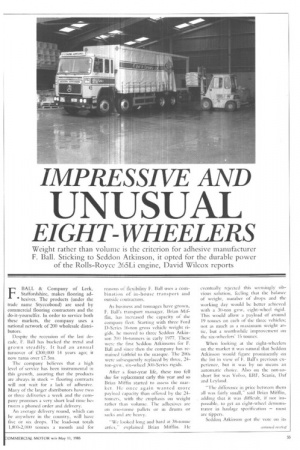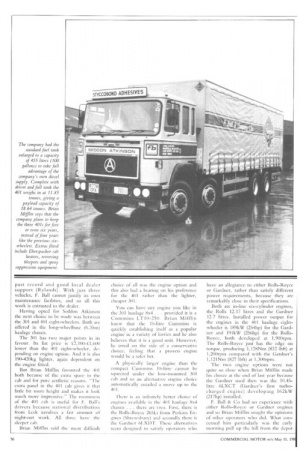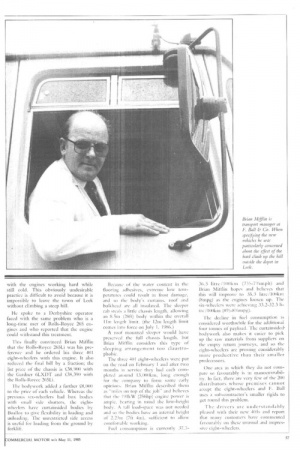IMPRESSIVE AND
Page 57

Page 58

Page 59

If you've noticed an error in this article please click here to report it so we can fix it.
UNUSUAL
EIGHT-WHEELERS
Weight rather than volume is the criterion for adhesive manufacturer F. Ball. Sticking to Seddon Atkinson, it opted for the durable power of the Rolls-Royce 265Li engine, David Wilcox reports FBALL & Company of Leek, Staffordshire, makes flooring adhesives. The products (under the trade name Styccobond) are used by commercial flooring contractors and the do-it-yourselfer. In order to service both these markets, the company uses a national network of 200 wholesale distributors.
Despite the recession of the last decade, F. Ball has bucked the trend and grown steadily. It had an annual turnover of 000,000 14 years ago; it now turns over £7.5m.
The company believes that a high level of service has been instrumental in this growth, assuring that the products are always in stock — flooring contracts will not wait for a lack of adhesive. Many of the larger distributors have two or three deliveries a week and the company promises a very short lead time between a phoned order and delivery.
An average delivery round, which can be anywhere in the country, will have five or six drops. The load-out totals 1,800-2,000 tonnes a month and for reasons of flexibility F. Ball uses a combination of in-house transport and outside contractors.
As business and tonnages have grown, F. Ball's transport manager, Brian Mifflin, has increased the capacity of the company fleet. Starting with three Ford 1)-Series 16-ton gross vehicle weight rigids, he moved to three Seddon Atkinson 200 I6-tonners in early 1977. These were the first Seddon Aikinsons for F. Ball and since then the company has remained faithful to the marque. The 200s were subsequently replaced by three, 24ton-gv w, six-wheel 300-Series rigids.
After a four-year life, these too fell due for replacement early this year and so Brian Miffin started to assess the mark et. He once again wanted more payload capacity than offered by the 24runners, with the emphasis on weight rather than volume. The adhesives are on one-tonne pallets or in drums or sacks and are heavy.
We looked long and hard at 38-tonne artics,explained Brian Mifflin. He eventually rejected this seemingly obvious solution, feeling that the balance of weight, number of drops and the working day would be better achieved with a 30-ton gvw, eight-wheel rigid. This would allow a payload of around 19 tonnes on each of the three vehicles; not as much as a maximum weight artic, but a worthwhile improvement on the six-wheelers' 1.5 tonnes.
When looking at the eight-wheelers on the market it was natural that Seddon Atkinson would figure prominently on the list in view of F. Ball's previous experience, but it was by no means an automatic choice. Also on the not-soshort list was Volvo, HU, Scania, Dal and Leyland.
"The difference in price between them all was fairly small,said Brian Mifflin, adding that it was difficult, if not impossible, to get an eight-wheel demonstrator in haulage specification — most arc tippers.
Seddon,. Atkinson got the vote on its
past record and good local dealer support (Rylands). With just three vehicles, F. Ball cannot justify its own maintenance facilities, and so all this work is entrusted to the dealer.
Having opted for Seddon Atkinson the next choice to be made was between the 301 and 401 eight-wheelers. Both are offered in the long-wheelbase (6.35m) haulage chassis.
The 301 has two major points in its favour. Its list price is 12,100-i1,600 lower than the 401 eight-wheeler, depending on engine option. And it is also 190-420kg lighter, again dependent on the engine fitted.
But Brian Mifflin favoured the 401 both because of the extra space in the cab and for pure aesthetic reasons. -The extra panel in the 401 cab gives it that little bit more height and makes it look much more impressive." The roonnness of the 401 cab is useful for F. Ball's drivers because national distribution from Leek involves a fair amount of night-out work. All three have the sleeper cab.
Brian Mifflin said the most difficult choice of all was the engine option and this also had a bearing on his preference for the 401 rather than the lighter, cheaper 301.
You can have any engine you like in the 301 haulage 8x4 . provided it is a Cummins LT 10-250. Brian Mifflin knew that the 10-litre Cummins is quickly establishing itself as a popular engine in a variety of lorries and he also believes that it is a good unit. However, he erred on the side of a conservative choice, feeling that a proven engine would be a safer bet.
A physically larger engine than the compact Cummins 10-litre cannot be squeezed under the low-mounted 301 cab and so an alternative engine choice automatically entailed a move up to the 401.
There is an infinitely better choice of engines available in the 401 haulage 8x4 chassis . . . there are two. First, there is the Rolls-Royce 265Li from Perkins Engines (Shrewsbury) and secondly there is the Gardner (iLX1)T. These alternatives seem designed to satisfy operators who
have an allegiance to either Rolls-Royce or Gardner, rather than satisfy different power requirements, because they are remarkably close in their specifications.
Both are in-line six-cylinder engines, the Rolls 12.17 litres and the Gardner 12.7 litres. Installed power output for the engines in the 401 haulage eightwheeler is 189kW (254hp) for the Gardner and 191kW (256hp) for the RollsRoyce, both developed at 1,900flam. The Rolls-Royce just has the edge on torque, producing 1,128Nm (832 lbft) at l,2(X)rpm compared with the Gardner's 1,121Nm (827 lbft) at 1,300rpm.
The two engine options were not quite so close when Brian Mifflin made his choice at the end of last year because the Gardner used then was the 10.45litre 6LXCT (Gardner's first turbocharged engine) developing 162kW (217hp) installed.
F. Ball & Co had no experience with either Rolls-Royce or Gardner engines and so Brian Mifflin sought the opinions of other operators who did. What concerned him particularly was the early morning pull up the hill from the depot
with the engines working hard while still cold. This obviously undesirable practice is difficult to avoid because it is impossible to leave the town of Leek without climbing a steep hill.
He spoke to a Derbyshire operator faced with the same problem who is a long-time user of Rolls-Royce 265 engines and who reported that the engine could withstand this treatment.
This finally convinced Brian Mifflin that the Rolls-Royce 265Li was his preference and be ordered his three 401 eight-wheelers with this engine. It also reduced the final bill by a fraction; the list price of the chassis is 08,900 with the Gardner 6LXDT and 08,390 with the Rolls-Royce 265Li.
The bodywork added a further £8000 to the price of each vehicle. Whereas the previous six-wheelers had box bodies with small side shutters, the eightwheelers have curtainsided bodies by Boalloy to give flexibility in loading and unloading. The unrestricted side access is useful for loading from the ground by forklift. Because of the water content in the flooring adhesives, extreme low temperatures could result in frost damage, and so the body's curtains, roof and bulkhead are all insulated. The sleeper cab steals a little chassis length, allowing an 8.Eun (28ft) body within the overall
in length lima. (the 1 2m length lama comes into force onjuly I, 1986.)
A roof mounted sleeper would have preserved the full chassis length, but Brian Mifflin considers this type of sleeping arrangement too claustrophobic.
The three 401 eight-wheelers were put on the road on February 1 and after two months in service they had each completed around 13,000km, long enough for the company to form some early opinions_ Brian IVliffitn described them as -miles on top of the joband believes that the I931‹.\1(/' (25611p) engine power is ample. bearing in mind the low-height body. A tall load-space was not needed and so the bodies have an internal height of 2.23m (711 4in), sufficient to allow comfortable working.
Fuel consumption is currently 37.7
36.5 litre /11thkrn (71/2-73/41nph) and Brian Mifflin hopes and believes that this will improve to 33.3 litreilOitkin (8mpg) as the engines loosen up. The six-wheelers were achieving 33.2-32.3 litre/100km (8 1/2-8-1/4nipg).
The decline in fuel consumption is considered worthwhile for the additional four tonnes of payload. The curtainsidedbodywork also makes it easier to pick up the raw materials from suppliers on the empty return journeys, and so the eight-wheelers are proving considerably more productive than their smaller predecessors.
One area in which they do not compare so favourably is in manoeuvrability. In fact, there arc very few of the 200 distributors whose premises cannot accept the eight-wheelers and F. Ball uses a sub-contractor's smaller rigids to get round this problem.
The drivers are understandably pleased with their new 401s and report that many customers have commented fivourably on these unusual and impressive eight-wheelers.




























































































